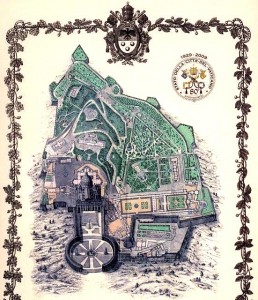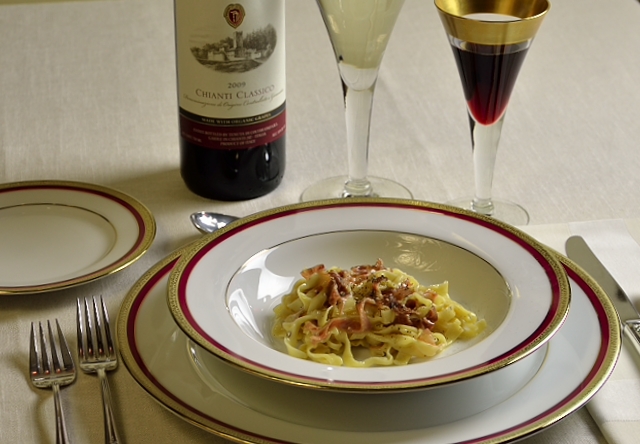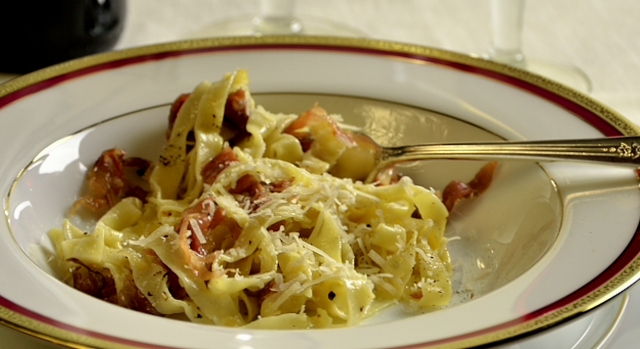Fettuccine alla papalina -The Pope’s Fettuccine
Mit brennender Sorge
History is a living thing, and whether ancient or recent, it is an exciting thing. Consider the Catholic Church, from tales of intrigue and blackmail, to Vatileaks, the sexual abuse scandal, and all the way to the Vatican Bank, it has some of the most exciting history of all. Even now she makes history as her princes have joined in conclave and elected a new Supreme Pontiff.
Vatican City
Man has but a few thousand years of recorded history, and so I am calling the late 1930’s recent. And nothing looms larger in recent history than Adolf Hitler and Nazism. Take for example the case of two popes, both named Pius, and that most infamous son of Austria. The relationship between the Third Reich and the Catholic Church has consumed historians for over seventy years. It’s a fluid sort of relationship – with new opinions being written and new information and research continuing even now.
 History intersects and entwines with every aspect of life. With Easter coming around and the election of a new Pope, I thought I’d devote some space to one of the most unique Papal Encyclicals ever produced, Mit brennender Sorge (With Burning Anxiety.) The year was 1937, and Pius XI occupied the Chair of St. Peter. Adolf Hitler was the Fuhrer and Reich Chancellor of Germany. By this time the Bishop of Rome had come to view the Reich Chancellor as an enemy of Christ bent on the destruction of the church. Further, he believed abuses committed against the Catholic Church, such as threats and violence, dismissals, trials and imprisonment of Catholic priests and nuns, were the work of Hitler himself. To combat this and to support the German bishops he put forth Mit brennender Sorge, an encyclical written not in the usual Latin, but in German, dated March 14, 1937. Authored largely by his Secretary of State, one Cardinal Eugenio Pacelli, the encyclical was smuggled into Germany and clandestinely printed.
History intersects and entwines with every aspect of life. With Easter coming around and the election of a new Pope, I thought I’d devote some space to one of the most unique Papal Encyclicals ever produced, Mit brennender Sorge (With Burning Anxiety.) The year was 1937, and Pius XI occupied the Chair of St. Peter. Adolf Hitler was the Fuhrer and Reich Chancellor of Germany. By this time the Bishop of Rome had come to view the Reich Chancellor as an enemy of Christ bent on the destruction of the church. Further, he believed abuses committed against the Catholic Church, such as threats and violence, dismissals, trials and imprisonment of Catholic priests and nuns, were the work of Hitler himself. To combat this and to support the German bishops he put forth Mit brennender Sorge, an encyclical written not in the usual Latin, but in German, dated March 14, 1937. Authored largely by his Secretary of State, one Cardinal Eugenio Pacelli, the encyclical was smuggled into Germany and clandestinely printed.
The Catholic underground, in a marvel of exquisite organization, mobilized to distribute it to churches across Germany, enlisting volunteers, many of whom were boys on bicycles. Copies were passed directly into the hands of priests, sometimes in the confessional, sometimes in the dark of night. At no point was it entrusted to the German postal service. The encyclical detailed Nazi abuses and made clear the Third Reich’s plan to dismantle the Catholic Church. It exhorted the faithful to extend their charity and live as Christians. This denunciation of Nazism was read simultaneously from pulpits across Germany on March 21, 1937, Palm Sunday.
Enraged, Hitler ordered the presses upon which it had been printed destroyed or confiscated. A new wave of arrests began followed by show trials and further censorship. Even children who distributed copies of the pamphlets after it had been read were detained.
Over the course of World War II Hitler and his war machine murdered thousands of Catholic clerics across Europe. Catholic schools were shuttered and churches closed. Catholic publications were heavily censored or closed down entirely. Yet, for all their efforts, the Nazis were unable to succeed in their ultimate goal. And this is where the great continuum of history intersects with life in real time. This week, with the rest of the world, I watched as the Church elected a new Pope, and I realized that 1.2 billion human beings today identify themselves as Catholics. Rebuke enough for Hitler.
 And where, you are wondering, does the fettuccine come in? Cardinal Pacelli, principal author of Mit brennender Sorge, had a favorite pasta dish of fettuccine enrobed in a cream sauce with sauteed onions, prosciutto and Parmigiano. In 1939 after the death of Pope Pius XI, Cardinal Pacelli was elected Pope. He took the name Pius XII, and the dish was given the name Fettuccine alla papalina. It’s history, and you gotta love it.
And where, you are wondering, does the fettuccine come in? Cardinal Pacelli, principal author of Mit brennender Sorge, had a favorite pasta dish of fettuccine enrobed in a cream sauce with sauteed onions, prosciutto and Parmigiano. In 1939 after the death of Pope Pius XI, Cardinal Pacelli was elected Pope. He took the name Pius XII, and the dish was given the name Fettuccine alla papalina. It’s history, and you gotta love it.
Finding the recipe was a bit of serendipity too. Last week I began to read Italian food historian Oretta Zanini De Vita’s new book Popes, Peasants, and Shepherds: Recipes and Lore from Rome and Lazio. Between the covers I found an absolute treasure trove, an enticing, beautifully written look at one of Italy’s less explored but tradition rich cuisines. I also found the story of this pasta dish. More intersecting and entwining.
Fettuccine alla papalina depends on the heat of the melted butter and just cooked pasta to bring the eggs to a food-safe temperature. If you are concerned about food borne illness see Food Nerd Notes below for information on pasteurized eggs.
Use your favorite egg pasta recipe or a packaged dry product, and dine like the Bishop of Rome.
Fettuccine alla papalina – The pope’s fettuccine
makes 4 servings
1 white onion
3 1/2 ounces (100g) sliced prosciutto
5 1/2 tablespoons (80g) butter
3 eggs
3 heaping tablespoons grated parmigiano-reggiano
2 tablespoons heavy cream
salt
14 ounces (400g) fresh egg fettuccine
pepper
Finely chop the onion and cut the prosciutto into narrow strips. Put the onion and prosciutto in a deep skillet with half the butter and saute over medium heat for about 4 minutes, or until golden brown. Meanwhile, break the eggs into a food processor, add 2 tablespoons of the parmigiano, the cream, and some salt, and process until smooth.
Drop the fettuccine into about 4 quarts (4 liters) boiling salted water. While it cooks, melt the rest of the butter in a small pan over low heat, then pour it into a warmed serving bowl. Add the egg mixture and mix rapidly to warm it up without scrambling the eggs from the heat of the butter. Next add the onion and prosciutto mixture. Drain the fettuccine when al dente and add to the bowl. Toss for a few seconds, then sprinkle with the remaining parmigiano and a little pepper. Serve immediately.
reprinted with permission from
Popes, Peasants, and Shepherds: Recipes and Lore from Rome and Lazio
by Oretta Zanini De Vita; Translated by Maureen B. Fant
Hardcover: 322 pages
University of California Press (March 26, 2013)
www.ucpress.edu
ISBN-10: 0520271548
ISBN-13: 978-0520271548
© Oretta Zanini De Vita
Further reading:
Consensus & Controversy by Margherita Marchione
A Cross Too Heavy by Paul O’ Shea
A Question of Judgment: Pius XII and the Jews by Joseph L. Lichten
Food Nerd Notes:
The Centers for Disease Control and Prevention (CDC) recommends that: Consumption of raw or undercooked eggs should be avoided, especially by young children, elderly persons, and persons with weakened immune systems or debilitating illness. Recipes containing eggs mixed with other foods should be cooked to an internal temperature of 160°F (71°C).
In-shell pasteurized Safest Choice Eggs from Davidson’s are widely available. At over $4.00/dozen, they are costly, but considering the risk of food borne illness, well worth the price. Visit the manufacturer’s website for purchasing information.
Note: You can click on any picture for a slide show!
I have no affiliation with any product, manufacturer, or site mentioned in this article.






Saturday, March 16th 2013 at 10:40 pm |
Un post delizioso pieno di interessanti informazioni , buonissime le fettuccine fatte così, molto romane! Buona domenica cara Adri, un abbraccio !
Sunday, March 17th 2013 at 12:00 am |
Grazie Chiara! Tempismo perfetto, no?
Saturday, March 16th 2013 at 11:53 pm |
Great post Adri! You are the BEST!
Sunday, March 17th 2013 at 12:04 am |
Thanks, Paola. I got very lucky with current events!
Sunday, March 17th 2013 at 6:17 am |
Well, this looks delicious. It has all my favorite food groups: pork, butter and cream.
Sunday, March 17th 2013 at 6:27 am |
Thanks, Elizabeth. Yes indeed, this one has it all!
Sunday, March 17th 2013 at 7:31 am |
Adri carissima è sempre un piacere passare dal tuo blog, ci sono sempre dei post molto interessanti e delle bellissime ricette. Un abbraccio e una buona domenica da parte mia!!!!
Sunday, March 17th 2013 at 7:50 am |
Grazie, Mariangela. Buona domenica a te!
Sunday, March 17th 2013 at 8:15 am |
Wow, what a great post Adri. I loved reading all the history about the papacy and WWII and how you managed to make it all come together with a great recipe at the end. You are the best and so is that pasta. It reminds me a bit of spaghetti alla carbonara, but with onions and prosciutto added. I could eat a huge plateful of that. I MUST get that book now.
Sunday, March 17th 2013 at 9:10 am |
Thanks,Linda,
I am so glad you enjoyed this. I love it when things come together so neatly! The book is an absolute gem. You will love it. And Bart and I finished all the pasta!
Sunday, March 17th 2013 at 8:18 am |
Bellissime le notizie storiche e delle fettuccine stupende, da assaggiare! Grazie e un bacione cara!
Sunday, March 17th 2013 at 9:11 am |
Ciao Ely,
Grazie per le tue gentilissime parole. Buona domenica!
Sunday, March 17th 2013 at 6:05 pm |
This reminds me of Spaghetti Carbonara, but I have always seen it with green peas added. Did Cardinal Pacelli not like his veggies??? Or was this his special version?
BTW, love the pictures.
Sunday, March 17th 2013 at 7:28 pm |
Ciao Foodie,
You’ve a keen eye for recipe development, caro lettore! It is a bit similar to Carbonara, though there are some important differences. Carbonara has its guanciale, bacon or pancetta, but no cream or onions and uses a dried spaghetti rather than fresh egg fettuccine. And as for the question of the peas – they did not appear in Cardinal Pacelli’s original pasta! I like them, and I think they round out the dish, adding a sweetness I enjoy. I’ll tell Bart you like the pix- – he’ll be glad to know. Grazie!
Monday, March 18th 2013 at 12:16 am |
This was such an interesting post to read, Adri. WWII was such a difficult time for the church in Rome, especially with Italy’s ruler Mussolini’s alliance with Germany. Many don’t realize that Catholics also suffered under Hitler.
I never knew that there was a special pasta named for a pope! It sounds so rich and delicious. I wonder what Pope Francis’ favorite cuisine will be?
Monday, March 18th 2013 at 6:56 am |
HI Pat,
Indeed a difficult time. And in yet another twist of history, a time not unlike though far greater in scope, than what Pope Francis faced in his own country under the junta. The older I get and the more I learn (funny how that works) the more I realize just how terrible it really was. The only way to honor those people is to “never forget.” I think the mantle of our generation must be to honor our fathers and make sure these stories are passed on.
And as for what Pope Francis enjoys – I’m on it!
Monday, March 18th 2013 at 6:27 am |
deliziose, quanto mi piacciono!!!!
Monday, March 18th 2013 at 6:56 am |
Grazie, Simona!
Monday, March 18th 2013 at 10:39 am |
Adri, I loved this post! I can’t tell you how much I enjoy your food history posts. And thank you for the cookbook recommendation! I have a nice Italian cookbook collection including a few from Oretta Zanini deVita and look forward to adding this one to the mix. Ciao! Michelle
Monday, March 18th 2013 at 5:15 pm |
Ciao Michelle,
I always worry that my history posts will bore readers, so thanks for the feedback! It’s good to hear that you are also a fan of Oretta Zanini De Vita’s work. Her books are really wonderful, and you will love this one!
Tuesday, March 19th 2013 at 11:30 am |
A scrumptious dish! I am a big fan of fettuccine.
Cheers,
Rosa
Tuesday, March 19th 2013 at 1:40 pm |
Hi Rosa,
I love it too. It’s the eggs, I think. It is so light and elegant. Thanks for stopping by!
Tuesday, March 19th 2013 at 4:10 pm |
non ci crederai stasera ero assente perche’ sono stata a cena da amici e cosa ho cenato pasta alla papalina ahhahahah che coincidenza
un piacere averti nel mio piccolo blog grazieeeeeeeee
Tuesday, March 19th 2013 at 4:17 pm |
Ciao Veronica,
Che coincidenza davvero! La vita e molto divertente. Grazie di essere passata dal mio blog, piacere di conoscerti. Alla prossima!
Tuesday, March 19th 2013 at 5:16 pm |
Un piatto delizioso e tutto il blog davvero fatto molto bene, complimenti
Tuesday, March 19th 2013 at 5:36 pm |
Ciao grazie Mariangela,
Il tempismo sia stato perfetto!
Wednesday, March 20th 2013 at 7:11 am |
This fettuccine are great! you’re very good! thanks for all the history that you describe! very interesting my dear Adri!
Wednesday, March 20th 2013 at 10:48 am |
Ciao Simona,
I am glad you like it. I was fascinated by the history, and the timing was perfect. Grazie!
Wednesday, March 20th 2013 at 10:04 pm |
Ciao, Adri–
Our sources claim that tradition dictates that a Pope always dines alone. However, this is certainly a dish meant to be shared!
Oretta Zanini de Vita is a national treasure and her Encylopedia of Pasta is not just a trusted reference book for us– as you demonstrate, its anecdotal details make for a riveting read even though the book contains no recipes!
Thursday, March 21st 2013 at 6:48 am |
Ciao!
Yes, this is just too good not to share. My, but the Pope has made us all take a look at all sorts of wonderful dishes, hasn’t he? You are so right about Oretta Zanini being a national treasure. Thanks for stopping by, and I look forward to your next installment on papal gustatory delights.
Friday, March 22nd 2013 at 7:06 am |
Love reading all about the history! And I’d loooove a bowl of this delicious fettuccine right now – it looks amazing!
Friday, March 22nd 2013 at 10:03 am |
HI Amy,
Thank you! The fettuccine is very tasty. Bart and I enjoyed it. And the good news about the history, there’s no quiz!
Friday, March 22nd 2013 at 8:07 am |
Cara Adri che articolo interessante. Crederci o no io la pasta alla PAPALINA non l’ho mai mangiata (e sono cresciuta in un quartiere di Roma vicino il Vaticano!!)ma l’ho sentita nominare tante volte: ora questa va direttamente sul mio menu’ della settimana…se trovo le uova pastorizzate: io sono terrorizzata dalle uova crude. La relazione tra il vaticano e il fascismo/nazismo e’ sempre stata controversa, un periodo storico da ricordare quello della seconda guerra mondiale, da ricordare perche’ non si ripetano piu’ gli stessi sbagli e atrocita’. PS adesso devo andare a vedere questo libro, mi sembra estremamente interessante. Sorry, I wrote the comment in Italian because it was difficult to tell everything in English.
Friday, March 22nd 2013 at 10:12 am |
Hi Rita,
No need to apologize. I got it! Yes, indeed, lots of controversy still surrounds this time. I can not even begin to imagine how much everyone suffered. As you say, it is important to be sure it never happens again.
Now how is it that you are from Rome, but never had this dish! You will have to try it soon. I also will not eat raw or undercooked eggs. Although very few people get sick, it is very bad for the few unfortunate individuals who do become ill, and I will not take a chance. I hope you can find some pasteurized eggs near you. This dish really is wonderful.
You will enjoy Oretta Zanini De Vita’s book. Visit her website – just click on her name in my article and it will link. She has a number of excellent historical articles there. Thank for visiting and for your thoughtful comments.
Friday, March 22nd 2013 at 2:53 pm |
What a spectacular post! I was unaware of the existence of this pasta and now I know everything there is to know about it!
Thank you.
Friday, March 22nd 2013 at 3:26 pm |
Hi Edith,
I am glad you enjoyed this. I hope you try this pasta. It is one of our favorites. Thank you for the kind words and for visiting!
Sunday, March 24th 2013 at 10:00 am |
I enjoyed the history behind the recipe for fettuccine alla papalina. I’m sure the dish is delicious.
Sunday, March 24th 2013 at 11:56 am |
Hi Karen,
It is good to hear that you enjoyed the history. The many threads of this wound together so very neatly, I just had to write about it! Thank you for your kind words, and thank you for visiting. It is a pleasure to met you.
Sunday, March 24th 2013 at 4:19 pm |
Brava Adri! Mouthwatering fettuccine!
Sunday, March 24th 2013 at 8:04 pm |
Benvenuta Silvia! Grazie!
Monday, March 25th 2013 at 5:14 am |
Adri — what a fantastic post! You know me, I am hopeless with food, but I love the history part. I had never heard of the Enyclical Mit brennender Sorge and it is the first time I have heard anything positive about Cardinal Pacelli standing up to the Nazis. Thank you so much for enlightening me. I love the name of the dish “Fettucine Papalina”, and I think maybe even someone as hopeless in the kitchen as I am just might be able to do it. Thank you!!
Monday, March 25th 2013 at 5:24 pm |
Hi Trisha,
I am glad you enjoyed this. The saga of Mit brennender Sorge is one of those seldom told tales, a remarkable testament to the faith and courage of the German Catholics. I hope you make the pasta. I bet your family would enjoy it. The dish has morphed a bit, and often today green peas are added to it. Just toss in about 3/4 cup of shelled baby green peas and saute them a minute or two with the prosciutto. By the way, Mit brennender Sorge would make a fine question for an interview with Padre Georg…
Monday, March 25th 2013 at 9:44 am |
Though I’ll admit Papal history bore me. Food lore is my ‘bread and butter’. So I found you tale (and use of the word entwining) very entertaining. GREG
Monday, March 25th 2013 at 5:34 pm |
Hi Greg,
I think there was a little something for everyone in this. I’m glad you enjoyed the Papal culinary lore. I just could not believe how everything came together once I got going and started researching. Also, this dish is fabulous. Really fabulous. I hope you try it!
Monday, March 25th 2013 at 3:31 pm |
Carissima, il tuo post è di un’interessante incredibile!Bellissimo e complimenti per la documentazione. Ci credi che non la conoscevo questa ricetta? L’hai presentata magnificamente e la visione della bottiglia di Chianti è il tocco finale.
Bravissima davvero.
Un caro abbraccio, Clara
Monday, March 25th 2013 at 5:45 pm |
Ciao Clara,
Che parole gentilissime! Adoro questo piatto. È anche buona con i piselli verde. Spero che lo provi! Alla prossima!
Tuesday, March 26th 2013 at 12:09 pm |
Che post interessante hai scritto! E che bella ricetta!
Tuesday, March 26th 2013 at 8:32 pm |
Grazie! Alla prossima!
Thursday, March 28th 2013 at 5:19 am |
grazie per questo bel post, molto ricco e completo di informazioni! ottima la ricetta!!!!
Thursday, March 28th 2013 at 6:29 am |
Grazie a te Artu!
Friday, April 5th 2013 at 8:53 am |
The ex-Roman in me is so glad you didn’t add peas to your papalina…
Friday, April 5th 2013 at 12:10 pm |
Hi Fran,
Yes, the question of peas loomed large here. I was grateful for the expert historical advice of Ms. Zanini De Vita. She said no peas. That made life simple.
Saturday, April 6th 2013 at 6:22 am |
Indeed. Even in Rome many restaurants add peas. I remember getting a semi-irate comment on my blog from a tourist who had just come back from Rome and said she ordered papalina in more than one place and it had peas every time, so there! Ah, the joys of blogging…
Saturday, April 6th 2013 at 7:07 am |
Hi Frank,
Indeed, the joys of blogging. On Facebook, not on my site proper, there were a number of comments on the question of peas. Chiara Giglio of La Voglia Matta shared the post on her page, and one of her readers asked “Where are the peas?” Chiara quickly responded that peas were a later addition, and the original recipe did not include them. If this is not a great example of how a recipe can morph into something different from the original, then I do not know what is. Although I have not seen it often on restaurant menus here in LA (especially not recently,) when I do it has always included peas. Thanks for sharing your reader’s observation that even in Rome this is the case.
Monday, April 22nd 2013 at 11:47 pm |
What an excellent read! I enjoyed your interesting article very much and to have a recipe also, that’s dinner sorted! I’m off to register for your site now.
A presto,
Lesley
Tuesday, April 23rd 2013 at 8:19 am |
Hi Lesley,
I am so glad you visited, and especially pleased to hear that you enjoyed the article. I am glad to help with dinner!
Tuesday, February 16th 2016 at 6:07 am |
Well done!